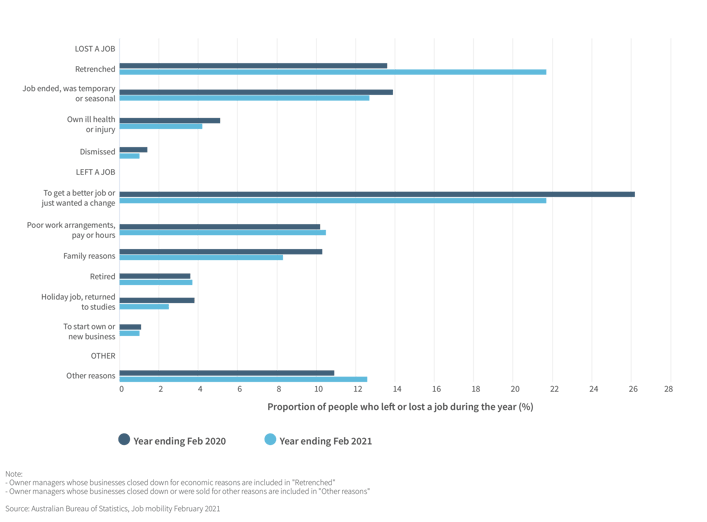Learn how offshoring improves your productivity and helps grow your business.
The comprehensive offshoring primer for business owners and managers.
Hear from some delighted clients, and see our staff and facilities for yourself.
All your questions answered. Even those you hadn’t thought to ask yet.
Recognitions, awards and important offshoring updates.
Build your team and see your savings immediately using this free tool.
Deep-dive into the details of offshoring. Research reports, fact sheets & more.
Can't find what you're looking for? View the full list of roles here.
What you need to know about “The Great Resignation”
Experts have referred to the mass number of employees expected to leave or quit their jobs during and after the pandemic as “The Great Resignation” or “The Big Quit”. The phenomena coined by Organizational Psychologist Dr. Anthony Klotz circles around the prediction that employees are having certain realizations surrounding the way they think about working, emphasizing remote work, leisure and leading a more fulfilling life not governed by the 9-5 work grind.

In this blog, we will discuss what caused the “The Great Resignation” and address the statistics, predictions for 2022 and what options are available to help organizations survive it.
What spurred the concept of “The Great Resignation”?
Dr. Anthony Klotz first addressed the predicted imminent flood of people voluntarily resigning in May 2021 while interviewing for Bloomberg. He stated that four reasons spurred the trend:
- Resignation backlog: employees who originally wanted to resign before the start of the pandemic ended up staying put when it was first introduced for fear of making any significant changes. However, with remote work and COVID-19 becoming the norm, workers have adjusted to this new reality. Their previous desire to resign has been “resurrected”.
- Burnout: Klotz points out, in particular, workers in the retail, hospitality and healthcare sectors, anyone in a front-line role and parents who have had to juggle work requirements with at-home schooling experienced burnout during the pandemic. Many workers had no reason to spend money with activities and travel on hold. With government financial incentives and this reduced spending, resignation ended up being the break they needed.
- Work-life epiphanies: forced remote work practices had people taking stock of their own lives and asking themselves, “am I living life the way I want to live it?” Lockdowns and quarantines gave people the time needed to reflect on different career paths: “is work giving me back as much as I’m giving it?”
- Remote work: at the start, working from home was a hard adjustment for many, but then, people started not to want to go back to the office. Many had done a 180-flip to prefer working from home over going into the office: less travel, more time with family, even better sleep-ins. So, when the time came to go back, many simply said no.
You know that saying “it's a buyers market” or “it's a seller's market” in real estate? Well, “The Great Resignation” can change that to “it’s an employees market” with labor shortages sweeping the economy. In America alone, as of the end of November 2021, there were 10.6 million job openings and in Australia, total job vacancies were 333,700 at the end of September 2021. This labor shortage has given employees the power to demand higher wages and more impressive benefits should they decide to look for work elsewhere.
A global, statistical interpretation of “The Great Resignation”
The latest statistics released by the Bureau of Labor Statistics (BLS) in America prove Dr. Klotz’s predictions are starting to come full-circle. In November 2021, the number of Americans who quit their job hit a series high of 4.5 million, increasing the quit rate to 3%. For comparison, this figure was an 8.9% increase from October and broke the previously held record of September, which was 4.36 million. The BLS broke down this figure further, segmenting it into industries. The largest increase in voluntary quitting that month was seen in accommodation and food services, followed by health care and social assistance, with transportation, warehousing and utilities not far behind.
In Australia, the term “The Great Resignation” may not be as appropriate as the more well-known phrase of “job-hopping”. The latest releases from the Australian Bureau of Statistics show that during the year ending February 2021, 1.8 million left or lost their job. Of those that left their jobs, 21.7% did so to get a better job or just wanted a change and 10.5% because of poor working hours or pay. LinkedIn shared figures that showed a 26% jump in workers changing employers in October 2021 compared with the same time in 2019.

However, data suggests that “The Great Resignation” is well on its way to Australian shores. Gartner’s Behavioral Scientist, Aaron McEwan, has stated that Australia’s job market gained back some confidence during the pandemic. To support this, Austrade’s Benchmark Report 2021 says how the Australian public sector debt ratio, by the end of 2022, will hit 43% of GDP. Compared with more advanced economies, this is well below the average forecast of 89%. However, McEwan points out that as we head into 2022, “people may not get bonuses that are as good as they hoped, miss out on promotions they feel they deserve or be properly thanked in performance reviews for their recent hard work.” Gartner anticipates the arrival of “The Great Resignation” as early as March 2022 in Australia, where it will be a “movement of talent we will be unprepared for”.
In Europe, “The Great Resignation” may not showcase figures as significant as America, but the main concept of employees starting to rethink their relationship towards work rings true, particularly younger generations. YPulse’s “What’s next for work” trend report showed 20% of millennials in Western Europe quit their jobs in 2021. Of that 20%, the top reasons included a better financial offer elsewhere (20%), their previous job was bad for their mental health (19%) or a promotion opportunity elsewhere (17%). 15% stated that the jobs they left behind had poor work-life balances, while an equal 13% left because they weren’t passionate about their jobs, didn’t get along with their employers and wanted more flexible working hours.
All in all, as of right now, the trend is most pronounced in America, but it’s evident from the above data and reports, there is potential for it to start catching on in countries around the world.
2022 work predictions and how organizations can battle “The Great Resignation”
So, what can organizations expect to happen to the way people work in 2022 because of this “Big Quit” phenomenon and the labor shortages gripping the job market? Here are four trends to expect:
Redefine flexible work practices
While the desire for fair pay, career growth opportunities and a positive workplace culture still exist, the pandemic has instilled a greater workplace benefit: flexibility. We aren’t talking about having a half-day on a Friday or starting work at 9 a.m. instead of 8 a.m. Instead, we are referring to the ability to work anytime and anywhere. Getting rid of the idea of total hours altogether and instead focusing on the deliverables and the due dates: “let me know what you want delivered and when it is to be delivered and I’ll make sure it is done.”
Organizations that focus on this will likely have an easier time attracting and retaining quality talent. Yes, it is a far stretch from the traditional 9-5 workplace mentality, but if COVID-19 has reminded us of anything, it’s that to survive in business, change is necessary.
Hybrid-work models
During the pandemic, and even today, many organizations were forced to send workers home to work remotely. Many organizations were concerned that employees would miss face-to-face workplace interaction and so now, with lockdown restrictions having eased, they have introduced hybrid work arrangements. Examples include letting employees decide if they want to work from home or the office every other day and so on. The research supporting this shows how virtual work has led to better in-team collaboration. Managers should assess each team member's job functions and remote work situations and customize these hybrid-work arrangements to suit. Instead of organization-wide mandates stating all employees work-from-home or in the office, managers know their team needs better and should be allowed to adjust work locations for employees as they see fit.
Substitutions for face-to-face communications
Face-to-face communication will always trump virtual communication, according to organizational behavior research. When a situation is complex, face-to-face communication is ideal for building trust in collaborative settings (like the workplace). If organizations continue remote work practices, then investments in HR-tech, such as engagement and job satisfaction surveys, are a must. Employees who may be completely virtual, either because of remote working practices or because they are offshore employees, will benefit from technology that allows them to get to know each other better more efficiently, like Zoom or Microsoft Teams.
Consider behavioral telemedicine
A positive aspect of the pandemic was the increase in transparency in having nonjudgmental conversations about mental health. Change can cause people to experience poor mental health symptoms and with many medical facilities closed during the height of the pandemic, the telemedicine industry shot up. Organizations started to catch on and offer telemedicine options to their employees, such as free virtual psychologist appointments or even hiring their own personal virtual psychologist services for their company.
Offshoring to combat labor shortages
With labor shortages gripping economies worldwide, organizations should consider alternative resourcing strategies, like offshoring, to fill positions. As it gets harder and harder to find quality candidates, offshoring allows businesses to access a larger talent pool anywhere in the world. With the influx of virtual communication tools and remote work guides available, it’s becoming easier for organizations to facilitate an efficient offshore component for their business.
To showcase how offshoring in the Philippines has provided these benefits to real-life organizations, we have created an eBook with 12 in-depth, real-world examples of organizations in industries as diverse as healthcare, eCommerce, insurance and tourism.
Popular posts
Newsletter sign up
Business growth and efficiency improvement hints and tips delivered direct to your inbox.
Related Posts
Global recruitment update 2023 - challenges, trends and strategies
At a time when terms such as ‘economic uncertainty’, ‘financial hardship’ and ‘looming recession’ dominate headlines, let us start by sharing some..
Philippines gig economy: The rise and risks
A lot has been written about the Philippines freelance boom in recent times, so much so that the phenomenon has earned its own moniker. Article after..
2023 skills in demand: fixing labor shortages
From March 10, 2020, the day prior to the World Health Organization's declaration of COVID-19 as a pandemic, to February 28, 2022, a total of 122,823..


















